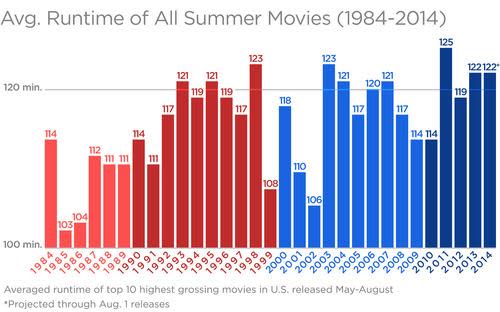Are Summer Blockbusters Getting Longer? A Breakdown by the Numbers

This past weekend saw the opening of Guardians of the Galaxy, which has been touted as a very different kind of summer blockbuster. And while, yes, it leans harder on comedy and quirkiness than the average superhero movie, it stands out for another reason: At 121 minutes, it’s downright short compared to most of the movies you’ve been sitting through for the past four months.
In fact, 2014 might go down as one of the most butt-numbing years in summer-movie history. That’s thanks, in part, to Marvel, the company that gave us such super-sized superhero movies as Captain America: The Winter Soldier (136 minutes), The Amazing Spider-Man 2 (142 minutes) and X-Men: Days of Future Past (131 minutes). But epic length is hardly relegated to just superhero fare; it’s becoming a hallmark of all blockbusters. Dawn of the Planet of the Apes is 130 minutes (having evolved 25 minutes longer than 2011’s Rise of the Planet of the Apes). And Transformers: Age of Extinction clocked in at an endurance-testing 165 minutes, a length bemoaned by film critics on Rotten Tomatoes and moviegoers on Twitter. (Not that that kept anyone away; ticket sales for the fourth installment in this toy-based franchise just surpassed $1 billion.)
Considering the last few years of non-stop Bayhem, marauding Pirates, and super-hero tentpoles, we should probably have grown accustomed to overlong run times by now. Yet bemoaning blockbuster lengths remains a favorite pastime for those who cover movies. “This cinematic bloating is totally unnecessary,” wrote Jim Slotek of the Toronto Sun recently. “It’s one of the paradoxes of our age. As attention spans get shorter – movies get longer.”
Some of our biggest summer franchises are microcosms for this runtime escalation: Transformers, Batman, Spider-Man and Pirates of the Caribbean entries have mostly gotten longer and longer throughout their multi-installment releases. (Though in its fourth go-round, Pirates was pared down to a mere two hours and seventeen minutes.)

“Speaking as a fan, I don’t understand it,” says Tim League, CEO of the film-fanatic-friendly Alamo Drafthouse movie chain. “To me, over-bloated runtimes suggest there are not enough brave souls surrounding creators to tell them the hard truth — you need to slash and burn; you need to have a concise story. While there is much to enjoy in these blockbuster films, many would benefit from a tighter focus with less characters and subplots.” However, Phil Contrino, chief analyst at BoxOffice.com, doesn’t believe moviegoers mind the extended runtimes, and that they create more of a “more bang for your buck” scenario. “In the eyes of fans, more really is better when it comes to these films,” he said. “The paying public clearly wants as much for their money as they can get, so the prolonged length of key tentpoles is not yet an issue.”
But are summer blockbusters actually getting longer, or is there a “in my day, movies were shorter and better and they cost a nickel!” effect going on, where they just seem longer? To find out, we got out our stopwatches and graph paper and looked at the last 30 years of summer releases.
First, let’s look at the average runtime of the top ten highest-grossing movies each summer. These were purely picked by gross, so they are a mix of all genres, not just your traditional blockbusters.

Summer runtimes were relatively low in the early ’80s, but that was before “summer blockbuster season” became a cultural touchstone. The average runtime first surpassed the two-hour mark in 1992, but Hollywood put out a more diverse mix of films back then: That summer combined popcorn fare (Batman Returns, Lethal Weapon 3) with dramas like Unforgiven and Far and Away. Average times would hover around the two-hour mark for most of the next decade. There were occasional spikes, like 1998’s summer of destruction, which let directors really take their time in destroying cities and planets in movies like Armageddon (151 minutes), Deep Impact (120 minutes) and Godzilla (139 minutes).
This graph doesn’t show a particularly dramatic rise, but it’s misleading since the past decade has seen a precipitous shift to where summer is totally dominated by the kinds of action franchises that never used to be this long. For example, the 1998 average was swayed by the 170-minute long Saving Private Ryan, a film that fell more under the category of Oscar bait, a genre with historically lengthier runtimes. And in general, there weren’t the kind of giant blockbuster outliers that would pull a year up. The longer movies of 1993 were the kind of CGI-less thrillers that are now rarely released in summer: The Fugitive (130 minutes) and The Firm (154 minutes). The king of the season, Jurassic Park, came in at 127 minutes, or nearly 15 minutes shorter than Christopher Nolan’s briefest Batman film.
When you filter out the adult dramas and Oscar bait and just look at the pure popcorn pictures — basically, anything where the action, effects and explosions are the main draw, from superhero movies to sci-fi epics and shoot-‘em-ups to crash-‘em-ups — a more dramatic graph reveals itself.

What we see is a more defined uptick in runtimes over the past three decades, albeit with some peaks and valleys. The first notable jump came in 1989, the summer of Tim Burton’s Batman (which was a summer movie game-changer in many ways, not just setting the precedent for superheroes who take their time); action movies leapt up to average a perfect two hours. We saw spikes again in 1994 (True Lies, Clear and Present Danger) and 1998 (another summer of destruction), and then a strange lull from 1999 to 2001, full of uncharacteristically short action movies like X-Men (104 minutes), Rush Hour 2 (90 minutes) and Jurassic Park III (92 minutes). Since then, action films have runtimes averaging two-hours-or-more every summer with the exception of two years, and have even climbed up to a record 128 minutes three times (2005, 2006 and 2012). This summer’s overall average actually marks a four-minute drop from 2013, on top of a four-minute drop from the previous year. It is worth noting, however, that the “primetime” summer action entries – movies released between May and mid-July, averaged a staggering 134 minutes; Late-July and August releases like Hercules (98 minutes), Into the Storm (89 minutes) and Sin City: A Dame to Kill For (102 minutes) helped bring us the number back down to earth.
Who or what is to blame? It’s hard to say. Perhaps the “more is more” ethos that has led studios to pile as many effects as possible into summer spectacles has helped stretch the running time. Or perhaps the very directors who have given studios these giant hits have gotten so much clout that execs can’t rein them in. (It bears noting that Judd Apatow’s successful comedies have been similarly criticized for needing a trim.) Let’s take a look at the runtime track records of some of summer’s biggest hit-makers.

James Cameron is technically the biggest offender when it comes to summer-movie bloat, with his movies running an average of 146.4 minutes, thanks to The Abyss (146 minutes), True Lies (144 minutes) and Aliens (137 minutes). (His two longest running films — Titanic, at 194 minutes, and Avatar, at 160 — were released in the fall.) Michael Bay is directly on Cameron’s tail with his films averaging 145 minutes — and a case can be made for naming Bay the true marathon champion, as he has directed nearly four times as many summer films as Cameron. Bay has never had a summer movie come in below two hours, and usually hovers in the 140-minute range. So the next time you find yourself developing bedsores during a summer movie, he is the man you should thank.
Additional reporting by Meriah Doty; Infographics designed by Jayme Perry

